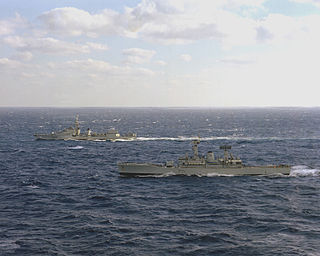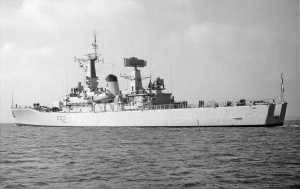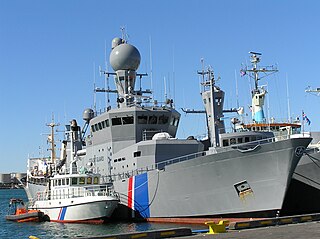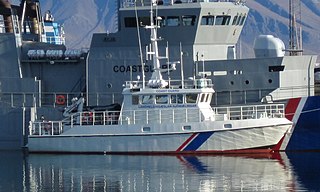The Cod Wars were a series of 20th-century confrontations between the United Kingdom and Iceland about fishing rights in the North Atlantic. Each of the disputes ended with an Icelandic victory.

HMS Scylla (F71) was a Leander-class frigate of the Royal Navy (RN). She was built at Devonport Royal Dockyard, the last RN frigate to be built there as of 2016. Scylla was commissioned in 1970, taken out of service in 1993 in accordance with Options for Change, and sunk as an artificial reef in 2004 off Whitsand Bay, Cornwall.

HMS Galatea (F18) was a Leander-class frigate of the Royal Navy. She was built by Swan Hunter & Wigham on the Tyne. She was launched on 23 May 1963 and commissioned on 25 April 1964 and was the eighth ship of the Royal Navy to bear the name.

HMS Diomede (F16) was a Leander-class frigate of the Royal Navy. She was built by Yarrow Shipbuilders in Glasgow. Diomede was launched on 15 April 1969 and commissioned on 2 April 1971. In 1998, the vessel was taken out of service and sold to Pakistan. Renamed PNS Shamsheer, the vessel served with the Pakistan Navy until being scrapped.

HMS Juno was a Leander-class frigate of the Royal Navy (RN). Like the rest of the class, Juno was named after a figure of mythology. She was built by Thornycroft of Woolston, Hampshire. Juno was launched on 24 November 1965 and commissioned on 18 July 1967.

The Icelandic Coast Guard is the Icelandic defence service responsible for search and rescue, maritime safety and security surveillance, and law enforcement. The Coast Guard maintains the Iceland Air Defence System which conducts ground-based surveillance of Iceland's air space and operate Keflavik airbase. It is also responsible for hydrographic surveying and nautical charting.

ICGV Týr is an Ægir-class offshore patrol vessel and the former flagship of the Icelandic Coast Guard. The ship was built by Dannebrog Værft in Denmark in 1974–1975 and entered service in 1975. Týr is the second largest ship in the Icelandic Coast Guard and participated in the Third Cod War. The ship conducted patrols, search and rescue, fishery inspections, general law enforcement and counter-terrorism operations in the Icelandic exclusive economic zone and the waters of the surrounding territories, such as Greenland and Jan Mayen. Týr was decommissioned in 2021 and sold in 2022.

ICGV Ægir is a former offshore patrol vessel of the Icelandic Coast Guard. Built by Aalborg Værft, in Denmark, she is the lead ship of the Ægir class and has one sister ship of an improved design, ICGV Týr. The ship entered service in 1968 and participated in the two last Cod Wars against the United Kingdom. Ægir primarily conducts patrols, search and rescue, fishery inspections, general law enforcement and counter-terrorism operations in the Icelandic exclusive economic zone. In 2020, the patrol vessel was taken out of service and sold two years later.

ICGV Óðinn is a decommissioned offshore patrol vessel formerly operated by the Icelandic Coast Guard. She is the oldest ship in the coastguard's fleet, and it is believed that her Burmeister & Wain engines are the only such engines that are still serviceable in the world today. Since her withdrawal from active duty, she has served as a floating exhibit at the Reykjavík Maritime Museum in Reykjavík Harbour. The ship is still maintained, and operative as of June 2022.

KD Hang Tuah is a frigate formerly operated by the Royal Malaysian Navy from 1977 until 2018. She is now a museum ship. She was built in the United Kingdom, originally for the Ghana Navy, but was launched and completed as a private venture, before being purchased by the Royal Navy in 1972. She served for five years as HMS Mermaid (F76) before being purchased by Malaysia, where she replaced another ex-British frigate also called Hang Tuah. She became a training ship in 1992 and was refitted to replace obsolete weapons and machinery.

HMS Russell was one of a dozen Blackwood-class frigates of second-rate anti-submarine frigates built for the British Royal Navy during the 1950s. She was named for Edward Russell, 1st Earl of Orford, commander at the Battle of Barfleur in 1692.

HMS Eastbourne was a Whitby-class, or Type 12, anti-submarine frigate of the Royal Navy of the United Kingdom.

The Overseas Patrol Squadron is a front-line squadron of the Royal Navy with responsibility for patrolling the UK's Extended Fisheries Zone, both at home and around British Overseas Territories. The squadron, with headquarters at HMNB Portsmouth, is equipped with eight of the River-class patrol vessels.
Ómar Torfason is an Icelandic former professional footballer. He was part of the Icelandic men's national football team between 1981 and 1989. He played 39 matches, scoring 1 goal. He won the Icelandic championship three times, in 1981 and 1982 with Víkingur, and in 1988 with Fram. He won the Icelandic Cup with Fram in 1985 and 1989. In 1985 he was the Úrvalsdeild top scorer with 13 goals.
Dirk Dunbar is an American former basketball player and coach. He was one of the first foreign players to play in Iceland where he led the Úrvalsdeild karla in scoring and won the Icelandic Cup in 1978.
Harry Eddom is a former English trawlerman. He was the sole survivor of the Hull triple trawler tragedy which claimed the lives of 58 Hull sailors in January and February 1968.

ICGV Þór was an offshore patrol vessel of the Icelandic Coast Guard. The third coast guard ship to bear the name, she was the flagship of the fleet and served in all three Cod Wars conflicts between Iceland and the United Kingdom.

Líf, also known as TF-LÍF, is an Aérospatiale AS-332L1 Super Puma helicopter used by the Icelandic Coast Guard. It is named after Líf, the only woman foretold to survive the events of Ragnarök from Norse mythology, and is the first Coast Guard aircraft to bear the name. It is the longest serving helicopter in the history of the ICG and gained national fame when it rescued 39 sailors in three separate incidents during a six-day period in March 1997.

ICGV Baldur is a patrol and survey vessel of the Icelandic Coast Guard. The ship was built by Vélsmiðja Seyðisfjarðar in Iceland in 1991 and entered service the same year. Over its three decade career it has been used for hydrographic surveying, patrol, law enforcement, exercises and various other projects along the country's shores. The ship is named after the Norse god Baldur and is the third coast guard vessel to bear the name.
The 1951 Glitfaxi air crash was a plane crash that occurred on 31 January 1951 when a Douglas DC-3 from Flugfélag Íslands, christened Glitfaxi, crashed in Faxaflói in Iceland, killing all 20 people aboard. It remains the second deadliest air crash in Iceland behind the 1947 Héðinsfjörður air crash.














